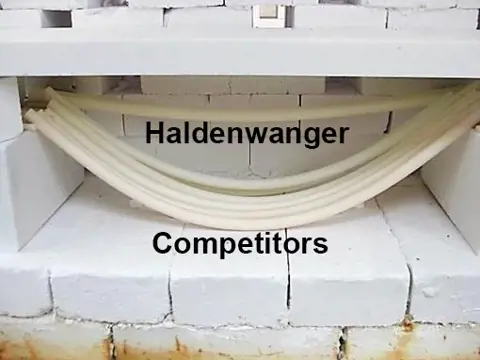Technical Ceramics

Compression and Creep
Contact usCompression Strength
Compression or compressive strength is the maximum compressive stress a test coupon of a material resists either before the coupon either deforms by a defined amount (e.g. 1%) or fractures.
Ceramics demonstrate exceptional compressive strength versus plastics due ceramics’ high rigidity. Among ceramics, silicon carbide and silicon nitride exhibit very high values (> 2500 MPa). Because of high compression strength and high hardness, silicon nitride is often used as devices to deform metal (e.g. can forming and tube bending/welding tools).
However, some ceramics are designed to plastically deform under compressive loads. The simple crystal structure of magnesium oxide allows it to flow during swaging and drawing, reaching near theoretical density. This is particularly useful in the manufacture of cartridge heaters to avoid damaging conductive elements.
Poisson’s Ratio, μ
When a test coupon of material is stressed in an axial direction, either when being stretched by axial tensile forces or when being compacted under axial compressive forces, Poisson’s ratio is the amount of strain that occurs in the test coupon in the direction perpendicular to the applied load divided by the amount of strain in the direction of the applied load. The direction of the applied load is often referred to as axial or longitudinal direction, and the perpendicular direction is the transverse of lateral direction. Strain is measured as the change in length over the original length (e.g. inch per inch). So, the equation for Poisson’s ration is represented as:
Poisson's Ratio = Transverse (Lateral) Strain / Axial (Longitudinal) Strain
The value is measured at a load before permanent plastic deformation occurs, meaning when the load is removed, the sample will return to its original form.
For many elastomers, Poisson’s ratio can approach 0.5 because there is a high amount of lateral dimensional change when a load is applied. For stainless steels, Poisson’s ration is about 0.3. For most technical or advanced ceramics, the values range between 0.18 and 0.3, meaning these ceramics will maintain their original form, under load, better than steel.
|
Material |
Poisson's Ratio at room temperature |
| Silicone Rubber | 0.499 |
| Gold | 0.42-0.44 |
| Silver | 0.37 |
| 80Pt-20Ir | 0.36 |
| Polyimide Film | 0.34 |
| Copper | 0.33 |
| Ti-6Al-4V | 0.33 |
| Aluminium 6061-T6 | 0.33 |
| MACOR® glass-ceramic | 0.28-0.29 |
| Silicon Nitride Ceramics | 0.28 |
| 410 Stainless Steel | 0.275-0.285 |
| 316L Stainless Steel | 0.25 |
| Zirconia Ceramics | 0.24-0.31 |
| Polysilicon | 0.22 |
| Alumina Ceramics | 0.19-0.25 |
| Fused Silica | 0.17 |
| Cork | 0 |
Creep
Creep is plastic deformation that occurs in a material when it is held under a constant load for a long period of time. The rate of creep versus time can accelerate as the temperature of a material is increased above the material’s softening point (generally 40-50% of the material’s melting point). The amount of load will also affect the rate of creep, and with ceramics, the rate of creep can also be affected by the ceramic’s porosity content and microstructure (grain size and shape).
Because technical ceramics have relatively high melting temperatures, creep may not be a design concern, particularly at use temperatures below 1000°C. However, many applications need to address creep as a potential failure mode. For example, it is recommended to vertically mount ceramic thermocouple sheathes at use temperatures above 1200°C to prevent deformation of the ceramic sheathe and consequential damage. Likewise, selection of an appropriate ceramic for kiln furniture is critical to avoid creep of the furniture and the associated impacts. Due to its unique microstructure, Alsint® 99.7 kiln furniture from Morgan Technical Ceramics is leading edge for its high-temperature creep resistance.

For metals, creep can be a limiting consideration at relatively low temperatures. For example, aluminium alloys can begin to creep at temperatures as low as 250°C, experiencing considerable plastic deformation, depending upon the applied load.



